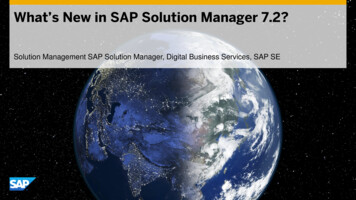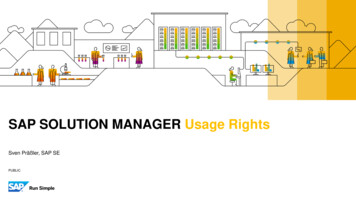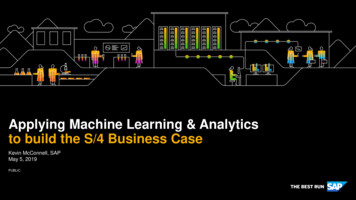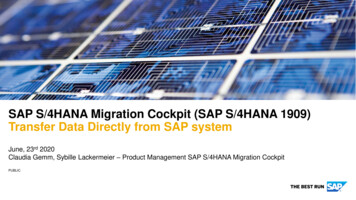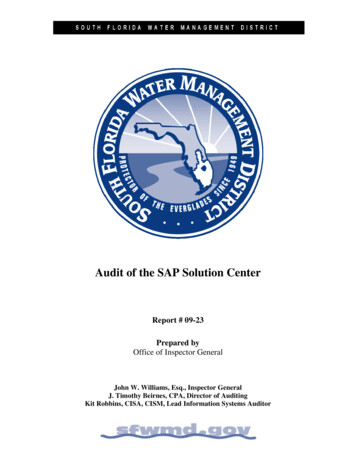
Transcription
Audit of the SAP Solution CenterReport # 09-23Prepared byOffice of Inspector GeneralJohn W. Williams, Esq., Inspector GeneralJ. Timothy Beirnes, CPA, Director of AuditingKit Robbins, CISA, CISM, Lead Information Systems Auditor
TABLE OF CONTENTSBACKGROUND . 1OBJECTIVE, SCOPE, AND METHODOLOGY . 4AUDIT RESULTS . 5Executive Summary .5Activities Adequately Support the District .7Extensive Use of Long Term Contracts Increases Overall Cost .7Benchmarking Shows the SAP System Can Be OperatedEffectively with Fewer Resources .9Business Plan or Business Case Needed .12SAP Steering Committee Has Not Met Timely .13Purchasing Unused SAP Modules and License Fees .15SAP Master Data Integrity Needs Improvement .16Change Control and System Stability .17Appendix A – Comparison of Contract Worker’sCost and Employee’s Salary .19Appendix B – Expenditures by Vendor and Fiscal Year .20
BACKGROUNDIn accordance with the Office of Inspector General’s Fiscal Year 2010 Audit Plan,we conducted an Audit of the SAP Solution Center. The SAP Solution Center providessupport for the District’s Enterprise Resource Planning (ERP) software, SAP. SAP(Systems, Applications, and Products) was started in 1972 in Germany and has grown tobe the world’s third largest independent software vendor and the world’s largest businesssoftware company with 97,000 customers in 120 countries.Compared toimplementations at other government organizations in South Florida, the District has hadgreat success in implementing SAP modules over the past five years. The SAP SolutionCenter has put in many long hours and extra work effort to create this success. The first“go live” of SAP was June 1, 2006. To date, the SAP modules implemented includeFinance, Project Systems, Procurement, Plant Maintenance, and Human Resources. Inaddition, Business Warehouse has been implemented for reporting. The software has aprimary function of being a standard application with online, real-time businessprocessing; however, the District has configured and customized the package for specificrequirements. The District has not customized the source code.Additional third party “add-on” software has also been implemented andinterfaced to and from SAP. These interfaces are not automatically integrated; therefore,programming in SAP was used to customize the interface and the SAP Solution Centercontinues to support these systems. Support for the “add-on” software results in highercosts than using standard SAP. The District chose to go with these software packagesbecause the corresponding functionality in SAP was non-existent or the SAP product wasvery limited in scope. The following is a list of some of these interfaced third partysystems. Kenexa – instead of SAP eRecruiting Success Factor – Performance Management System dcLINK – Asset Management Barcodes/Inventory management IRIS (Integrated Real Estate Information System) – Oracle Business Warehouse Prometheus – Planning and scheduling for Plant MaintenanceOffice of Inspector GeneralPage 1Audit of the SAP Solution Center
BSI – Payroll tax calculations Winshuttle – Interact with SAP from Excel EPI-USE – Landscape Management Products – Data Sync Manager Mercury Tools – Interactive Testing Tools LoadRunner – Architecture Performance and Volume Stress TestingIn September 2008, the District was the second public sector customer to begin acontract with SAP to implement the Public Budget Formulation (PBF) module. This isan SAP add-on component originally developed by the SAP development group andBudgetec LLC, a consulting firm based in Fort Lauderdale, Florida. On March 9, 2010,Optimal Solutions Integration Inc. acquired Budgetec, LLC. The new “go live” for thismodule is scheduled for late March 2011.The additional modules that are planned to “go live” in the future are Governance,Risk, and Compliance (GRC), and Supplier Relationship Management (SRM). TheDistrict has purchased the software and is currently paying for maintenance on thesemodules; however, the implementation project for these modules has not commenced yet.As of May 7, 2010, the SAP total costs are in excess of 82.5 million. 72.7million is consulting costs, hardware, software, training, etc. and 9.8 million is Districtsalaries and benefits. Of the 72.7 million, approximately 69.3 million has been fromFY05 to the present. This 69.3 million over five and a half years averages over 12.6million a year. Deloitte was paid 15.7 million for the initial SAP implementation. TheSAP Solution Center budget for FY10 is estimated to be 10 million for professional andexternal contract services. The following table displays the historical costs.PhaseInitiation andPlanningImplementationand SupportDistrict Salariesand BenefitsYearsFY01 to FY04Cost*(millions) 3.4FY05 to May 7, 2010 69.3FY01 to May 7, 2010 9.8Total Costs 82.5* As of May 7, 2010Office of Inspector GeneralPage 2Audit of the SAP Solution Center
In December, 2009, the SAP Solution Center had six full time employees. TheSAP Solution Center underwent some reorganization, which included moving five fulltime equivalent employees from the IT Department to the SAP Solution Center. Thechanges were designed to build a better operational model, increase efficiency, andincrease the quality of SAP service.As of April 1, 2010, the SAP Solution Center consists of approximately 12 fulltime equivalent employees, along with 24 contract workers. The table below shows thenumber of employees and contract workers broken out between technical versusfunctional workers.SAP Solution Center*Technical (IT and BW*)Functional (FI, PS, MM, PM,PBF*)TotalsFull Time Equivalents66Contract Workers1113Total1719122436*Note that as of 7/20/10, the solution center has 13.5 employee FTEs and 19 full time contractors for a totalof 32.5 total resources. Three full time employees that report to HR-related departments spend the majorityof their time working with the SAP Solution Center but are not included in the above table; however, theyare sometimes included within the SAP Solution Center Department Organizational Chart.*IT Information Technology, BW Business Warehouse, FI Finance, PS Project Systems, MM Materials Management, PM Plant Maintenance, and PBF Public Budget FormulationThe SAP Solution Center follows the Project Management Institute (PMI)standards, and the Capability Maturity Model Integration (CMMI) software developmentand application implementation standards. There have been multiple user requirementsand additional scope and modules to satisfy the business expectations. Recommendationsfor additional modules and proposed actions have been created without a business caseand more than half of the changes in SAP for the past year have been programming. Thevalue of an integrated standard SAP system is choosing a package software product thatis already programmed with standard best practice business processes.Office of Inspector GeneralPage 3Audit of the SAP Solution Center
OBJECTIVE, SCOPE, AND METHODOLOGYThe overall objective of our audit was to determine whether the SAP SolutionCenter is meeting its goals and is operating efficiently and effectively. Specifically, ourobjectives focused on determining the different specialty SAP skills versus routinemaintenance skills and how the District’s contractors and staff fill these roles.Inaddition, we determined whether the system capabilities could be enhanced to fullyrealize the District’s investment. The District’s business solutions and the costs were themain focus. Evidence was gathered through inspections, analyses, and observations toachieve our audit objectives. Recommendations were made where we identified areas forimprovement, and cost savings.To accomplish our objectives, we interviewed some contractors and other relevantDistrict SAP Solution Center staff responsible for the support of SAP, reviewed projectdocumentation, reviewed system documentation, reviewed organizational charts, anddeveloped a cost benefit analysis based on the current SAP contracts for consultingservices.The methodology included interviews with system administrators, systemowners, SAP Solution Center staff, and District contractors to ascertain the status,maturity, and overall efficiency of the SAP Solution Center. The scope included thereview of the current efficiency and effectiveness of the SAP Solution Center.Our audit was conducted in accordance with Generally Accepted GovernmentAuditing Standards (GAGAS). These standards require that we plan and perform theaudit to obtain sufficient, appropriate evidence to provide a reasonable basis for ourfindings and conclusions based on our audit objectives. We believe that the evidenceobtained provides a reasonable basis for our findings and conclusions based on our auditobjectives.Office of Inspector GeneralPage 4Audit of the SAP Solution Center
AUDIT RESULTSExecutive SummaryOverall, our audit revealed that the SAP Solution Center has adequate planning,budgetary and project management control processes in place to ensure that the activities,projects, and applications support the District’s business processes and meet theoperational needs. A review of the business solutions that the SAP Solution Center staffintended to achieve disclosed that great progress has been made through the partnershipwith the Information Technology Department over the past years. The SAP systemcurrently can sufficiently support the District’s mission regarding water quality, floodcontrol, natural systems, and water supply, by having the capability to report from onesystem and one set of data. However, following are some additional enhancements werecommend to fully realize the efficiency of the District’s investment in SAP. Replace contract workers with full time employees, which would saveapproximately 4.7 million annually. Consider hiring full time employees forSAP Solution Center positions considered permanent and ongoing and eliminateconsultants from having Team Lead positions within the SAP Solution Center bycreating a plan for knowledge transfer from the existing consultants. Develop a three year SAP Strategic Plan for maintenance that flows logically intothe Information Technology Strategic Plan and ultimately into the DistrictBusiness Strategic Plan.This should include partnering with InformationTechnology and the SAP Solution Center for knowledge transfer and additionalFTE’s after the Governing Board has approved all business projects that enhancethe SAP system. Renegotiate current SAP consulting rates from implementationrates down to maintenance rates. Develop and keep a business case current since it is the key input to decisionsmade throughout the life of the project and to help the Project Sponsors assesswhether project modifications and scope changes are adding business value. Consider delaying the Public Budget Formulation (PBF) Project until a greaternumber of SAP Public Sector customers have successfully implemented theproduct.Office of Inspector GeneralPage 5Audit of the SAP Solution Center
Simplify the SAP Solution Center by using the value of an integrated standardSAP package software product that is already programmed with best practicebusiness processes. Move back toward the original goal of redesigning Districtprocesses to fit SAP instead of customizing and programming SAP to fit Districtprocesses. Conduct the Internal Controls Committee meetings on a timelier basis in order tohelp prioritize Project Sponsor’s business goals and scope definition with the SAPSolution Center. Review all contractors quarterly, for which annual charges exceed 200,000. Planfor all contractors within the SAP Solution Center to have a shadow full timeemployee and to roll off after a maximum of two years of service. Roll the existing contractors off based on the current five year SAP contract anduse the IT Department’s Project Management Office (PMO) for projectmanagement instead of contractors. Bring the total resources down to between 5to 9 consultants within a 9 month window. Develop clear business support and a plan prior to purchasing additional softwareproducts. Renegotiate maintenance fees back to 18% with SAP. Provide appropriate level of attention and detail to master data because poormaster data negatively impacts the overall integrity of the system.standardization of business processes is driven from the master data.Office of Inspector GeneralPage 6Audit of the SAP Solution CenterThe
Activities Adequately Support the DistrictThe SAP Solution Center has performed an adequate service when it comes toapplication functionality and user expectations. The testing of the evidence proves thebusiness processes across the District have been accomplished based on their statedobjectives. Most requirements have been met. This has been solidified through the usershaving the business requirements and specifications come together based on the businessimpact analysis. There has been a demonstration of the progress by customizing theapplication functionality of SAP from the standard software to the District’s specializedsoftware. We noted that the budget development process also helps to ensure that theSAP Solution Center’s activities support District goals, since funding decisions are madeaccording to the District’s strategic priorities.However, we believe that the SAPSolution Center could achieve its objective more cost effectively as noted in othersections throughout this report.Extensive Use of Long Term Contractors Increases Overall CostSAP outsourcing is common for an initial implementation partnership to improveservice and efficiency levels, manage internal workload, provide specific expertise, andget the system up and running. Continued SAP outsourcing may be used to add businessvalue, streamline processes, provide staffing augmentation for limited term projects, andprovide specific, niche SAP skills.On June 1, 2006, the SAP Solution Center Department employed approximately 7full time equivalent (FTE) employees and used Deloitte at a budgeted cost ofapproximately 15 million.Since the “go live”, approximately 31 or more annualcontract workers provided services, at a budgeted cost of approximately 10 millionannually. Some of the contract workers are used for project management and short termprojects like Public Budget Formulation (January 2009 to the present); however, contractworkers are also used for maintenance activities that are long term, recurring, andpermanent in nature. While it may be cost effective to use contractors for short termprojects, or projects requiring highly specialized SAP knowledge, the use of contractorsmay not be appropriate or cost effective in all cases. Positions which are of a long termor permanent nature may be more cost effective if filled by hiring full time employees.Office of Inspector GeneralPage 7Audit of the SAP Solution Center
For example, Project Management could be filled by certified Project ManagementProfessionals (PMP’s) within the IT Department Project Management Office (PMO).Through discussions with SAP Solution Center personnel we identified 22 out of24 outsourced positions that were considered to be of a necessary, ongoing, andpermanent nature. The other two contractors perform administrative functions for theSAP Solution Center staff and are well below the SAP implementation rates.Weanalyzed the cost of these 22 positions by reviewing the outsourcing contracts for each ofthe 22 positions. We then reviewed the appropriate District job descriptions, salarygrades and other employment expenses applicable to the outsourced positions assumingthat the positions could be filled with internal District staff. The results of our analysisare shown in the following table:Annual Cost Comparison*Staffing MethodAmountCost to Contract 7,108,254In-House Staff Cost2,396,793Difference – Amount 4,711,461Difference - Percent197%*Complete details are shown in Appendix AAs shown in the above table, the cost for a contract worker to perform SAPSolution Center functions was, on average, approximately 197% higher than hiring anemployee to perform the same services. Our calculations revealed that approximately 4.7 million could be saved annually if the services performed by these 22 contractworkers were performed by District staff. Note that this assumes 40 hour work weeks forcontractors, which is conservative based on the review of the 2010 current status reportsand the possible six day work week for the Public Budget Formulation (PBF) project. Ofthe 22 contract workers, 5 charge between 110 and 150 per hour and the remaining 17charge between 150 and 210 per hour. The results of our analysis show the annualbreakdown by vendor in the following table:Annual Total by Vendor*Staffing FirmAmountMeridian 3,192,800Zenith / Intellisoft 2,106,021AL Jackson 1,570,234Others 239,200*Not including 40 hours per weekOffice of Inspector GeneralPage 8Audit of the SAP Solution Center
Recommendations1. Consider hiring full time employees for SAP Solution Center positionsconsidered permanent and ongoing.Management Response: Management agrees.Responsible Department: SAP Solution Center / Human Resources/UpperManagement/Governing BoardEstimated Completion: Ongoing until all positions are filled (targeting 3 yearprocess) – 9/30/132. Eliminate consultants from having Team Lead positions within the SAP SolutionCenter by creating a plan for knowledge transfer from the existing consultants.Management Response: By 8/6/10 District employees will lead all three criticalareas of the project: technical, functional and overall project management.Responsible Department: SAP Solutions Center / Various Business Units involvedin projects / IT (PMs for projects)Estimated Completion: 8/6/10Benchmarking Shows the SAP System Can Be OperatedEffectively with Fewer ResourcesGartner, Inc. is a neutral service group that delivers the world’s leading insightand research in information technology. They help global technology leaders makestrategic and informed decisions. After review of the IT Key Metrics data (ERP/SAPPerformance Measures) for 2010, we examined the total number of resources within theSAP Solution Center and compared these to the best practices established by the Gartnerresearch. Based on the 1,842 total District named users and the concurrent users ofapproximately 140, the total annual cost for SAP should be around 2.5 million and thenumber of resources should be approximately 17 FTE’s.Office of Inspector GeneralPage 9Audit of the SAP Solution Center
Another benchmarking SAP customer we used is Gwinnett County, Georgia.They are an SAP Public Sector customer that is twice the size of the District with 4,800plus users and approximately 400 concurrent users. They have all the modules that theDistrict has, with the exception of Public Budget Formulation (PBF), plus they haveSRM (Supplier Relationship Management), CRM (Customer Relationship Management),and ISU (Industry Specific Solution for Utilities). They went from 28 consultants downto 4 in a 6 to 9 month timeframe. This was done based on a plan to hire some of theconsultants as full time employees. They currently have 24 total resources supportingSAP, including the 4 consultants.This county paid approximately 4.8 million annually for 28 SAP consultants andthe District currently pays approximately 7.1 million annually for 22 consultants. Thisshows the District is still paying implementation rates 4 years after the “go live”.Typically, maintenance rates are lower than implementation rates.Some consultants still work “off site” on some days. Although it can be arguedthat SAP related work can be done remotely, little to no knowledge transfer can happenfrom the consultants if they do not work directly with District staff during District staffhours. Having a strategic plan to move toward full time employees and possibly hiringsome existing consultants or qualified SAP experienced professionals should help thetransition of the SAP Solution Center.An additional benchmarking SAP customer is the Department of Revenue for thestate of Florida. They are a SAP Public Sector customer that has one instance of SAPthat is similar in size to the District. They have 2,000 plus users and approximately 200concurrent users on their SAP instance for general tax administration. The Department ofRevenue has most of the modules that the District has, with the exception of PublicBudget Formulation (PBF). The Department of Revenue has the SAP Portal, CRM(Customer Relationship Management), FICO (Finance and Controlling), SD (Sales andDistribution), and BW (Business Warehouse). They went from 30 plus consultants downto 8 and are in the third year of maintenance. Their average SAP consultant rate is about 100 per hour.This was accomplished based on a plan to train and transition ITresources as full time employees within the SAP application development division.Office of Inspector GeneralPage 10Audit of the SAP Solution Center
They currently have 30 to 35 total resources supporting SAP.SAPCustomerTotal UsersConcurrentUsersNumber aCountyFlorida StateDepartmentDistrictAnnualSpending 2.5 milliontotal SAPspendingCurrentConsultantsTotalResourcesNA1728 4.8 million42420030 6.2 million830 - 3514022 7.1 million2439Recommendation3. Develop a three year SAP Strategic Plan for maintenance that flows logicallyinto the District Business Strategic Plan.Management Response: Management agrees.Responsible Department: SAP Solution Center / Executive Management / HREstimated Completion: 12/31/104. Use benchmarking and industry standards to determine appropriate staffinglevels and expenditures.This should include partnering with InformationTechnology for knowledge transfer and additional FTE’s.Management Response: Management agrees.Responsible Department: SAP Solution CenterEstimated Completion: Ongoing (targeting 3 year process) – 9/30/135. Renegotiate current SAP consulting rates from implementation rates down tomaintenance rates.Management Response: Management concurs and steps are being taken to gain ratereductions from existing vendors.Responsible Department: SAP Solution Center / ProcurementEstimated Completion: Initial Phase by 12/31/10Office of Inspector GeneralPage 11Audit of the SAP Solution Center
Business Plan or Business Case NeededAs there is great value in having one quality ERP system and a business need forthe SAP system, the business case used to support the procurement of consultants andinstallation of Public Budget Formulation (PBF) is nonexistent. It is unknown whetherthe implementation, use, and reconciliation of the information will be worth theprioritization of this business project.In general, the Information Technology Strategic Plan and the District-widegovernance vision delineate a standard for the creation of a business case for all majorprojects.This establishment by management allows the leadership team to makeknowledgeable business decisions in regards to future SAP priorities for businessprojects. Portfolio management manages the business risk and the value to the businessof these projects. The reason for “what is” not being equal to “what ought to be” can be achallenge to identify in some projects. District-wide governance best practices use thebusiness case and portfolio management to prioritize business projects. Projects withextended timeframes and expanded needs of scope increase the degree of risk and cost forthe District. The continued extension of contractors is just one example of this risk andcost. A project should not be recommended before reviewing an updated business case.Without an updated business case, the decision makers will have a more difficult timethroughout the life of the project. The main benefit of addressing the managementleadership with the challenge of having these business cases is that the District will showDistrict-wide governance vision with prioritized business projects.Recommendation6. Develop and keep a business case current since it is the key input to decisionsmade throughout the life of the project and to help the Project Sponsors assesswhether project modifications and scope changes are adding business value.Management Response: Management concurs and will track and communicatereturn on investment (ROI).Responsible Department: SAP Solution Center / Business AreasEstimated Completion: Mid-March 2011Office of Inspector GeneralPage 12Audit of the SAP Solution Center
7. Consider delaying the Public Budget Formulation (PBF) Project until a greaternumber of SAP Public Sector customers have successfully implemented theproduct.Management Response: Since over 85% of the budget for this project has alreadybeen invested in the project, management believes that continuing this project tocompletion is the right decision.Because this is a beta implementation, it isanticipated that additional training and support from SAP above what is afforded on astandard implementation will be made available.Responsible Department: PBF Steering CommitteeEstimated Completion: Mid-March 2011; issues and budget monitored on anongoing basis going forward.8. Simplify the SAP Solution Center by using the value of an integrated standardSAP package software product that is already programmed with best practicebusiness processes. Move back toward the original goal of redesigning Districtprocesses to fit SAP instead of customizing and programming SAP to fit Districtprocesses.Management Response: Management agrees and the original goal of not alteringSAP code has been met.Responsible Department: SSC / Business PartnersEstimated Completion: Initial Phase by 12/31/10SAP Steering Committee Has Not Met TimelyAlthough there is an Internal Controls Committee, a formal SAP SteeringCommittee has been lacking for the past year. The last Internal Controls Committeemeeting was held in June, 2009. The District should hold an SAP Steering CommitteeMeeting on a monthly basis with minutes distributed to the team based on decisions.After the Governing Board had approved the SAP contract with five sections andthe winning staffing firms, there may have been an understanding that the Executive levelupdates were complete. The District is moving along with approximately a 13 millionOffice of Inspector GeneralPage 13Audit of the SAP Solution Center
annual rate of SAP spending that has multiple sections of SAP scope and phasesremaining without direct “steering” from upper management. As of April 1, 2010, 16 ofthe 22 SAP consultants have been here at the District for more than 3 years and 10 ofthese have been here at the District for more than 4 years.Recommendation9. Conduct the Internal Controls Committee meetings on a timelier basis in orderto help prioritize Project Sponsor’s business goals and scope definition with theSAP Solution Center.Management Response: Management concurs.Responsible Department: CFO Office / SAP Solution Center / Business AreasEstimated Completion: 8/30/1010. Review all contractors quarterly, for which annual charges exceed 200,000.Management Response: Management concurs.Responsible Department: SAP Solution Center / ProcurementEstimated Completion: Initial Phase by 12/31/1011. Plan for all contractors within the SAP Solution Center to shadow a full timeemployee and to roll off after a maximum of two years of service.Management Response: Management concurs with the spirit of thisrecommendation. Converting contract support to FTEs where appropriate and costeffective will be pursued. For certain specialized functions, or short term needscontractual support will likely continue to be needed into the future.Responsible Department: SAP Solution Center / Upper ManagementEstimated Completion: Ongoing until all positions are filled (targeting 3 yearprocess) – 9/30/13Office of Inspector GeneralPage 14Audit of the SAP Solution Center
12. Roll the existing contractors off based on the current five year SAP contract anduse the IT Department’s Project Management Office (PMO) for projectmanagement instead of contractors. Bring the total resources down to between 5to 9 consultants within a 9 month window.Management Response: Management again concurs with the spirit of thisrecommendation. Converting contract support to FTEs where appropriate and costeffective will be pursued. For certain specialized functions, or short term needscontractual support will likely continue to be needed into the future.Responsible Department: SAP Solution Center / Business in GeneralEstimated Completion: (targeting 3 year process) – 9/30/13Purchasing Unused SAP Modules and License FeesThe District purchased additional SAP modules for Governance, Risk, andCompliance (GRC) and Supplier Relationship Management (SRM) in August, 2009 for atotal of 684,000.Governance, Risk, and Compliance module was purchased for 420,000 for 2000 users and Supplier Relationship Management module was purchasedfor 264,000 for 492 users. The District has started the installation of Governance, Risk,and Compliance in a development/sandbox environment on May 18, 2010. The Districthas not installed Supplier Relationship Management. Duet is another software productthat was purchased and not yet installed. This Duet softwar
Materials Management, PM Plant Maintenance, and PBF Public Budget Formulation The SAP Solution Center follows the Project Management Institute (PMI) . Office of Inspector General Page 7 Audit of the SAP Solution Center Activities Adequately Support the District The SAP Solution Center has performed an adequate service when it comes to .




